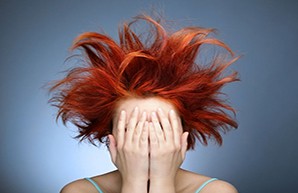Suffering from bad hair, day after bad hair day?
Fine fly-aways, split ends and the frizzies can be symptomatic of your hair type but can also be because of the condition your hair is in. If you've been abusing your locks, it might be time to admit your tresses into hair rehab and sort them out.
Freaking out about frizz
The first thing that is important to remember is that naturally curly hair is naturally drier too. “This type of hair automatically lacks moisture because it's unable to hold onto it,” explains hair guru Shelene Shaer, stylist and co-owner of Joburg's Tanaz Hair, Body and Nails.
YOUR REHAB PROGRAM: The best thing to do with this hair type is to make peace with your curls;
accepting your hair type and working with what you have will help you to enjoy it more. And of course, the less you mess with it, the less damage you do. But if that suggestion leaves you cold, then chat to your hair stylist about cutting it to a length that's easy for you to blow dry at home. Shaer advises keeping it longer (depending on its thickness) which makes it more manageable. And, colour-wise, think darker rather than lighter. “The darker your hair, the more healthy it'll look but the lighter, the more damaged it'll look,” she explains.
Fine fly-aways
Wispy bits are a nightmare if you're trying to pull off a polished ponytail or sleek blow dry. While fine hair is at risk of fly-away strands, new hair growth (especially around the hair line) can also be tricky to manage. Your approach needs to be two-fold: get the right haircut and then shop for the right products to help you achieve controllable hair at home.
YOUR REHAB PROGRAM: A solid bob (choose a length that suits you) works for this type of hair. 'The less texture you have and the fewer layers cut into your hair, the better.' Shaer also dispels the myth that conditioner shouldn't go near fi ne hair. ‘Most people are under the impression that you shouldn’t use conditioner on fine hair but for fly-aways you actually need to decrease static by using a conditioner.' She also explains that a good shampoo and conditioning duo play a huge role in controlling your hair - together with the right haircut of course. And to ensure your hair really looks groomed, shop for a light-hold hairspray - the perfect styling aid for this hair type.
Having hair fall-out?
Perhaps you've scorched your locks with too many vigorous strokes of the flat iron?
Or perhaps your braids have caused major breakage around your hairline? Whatever your hair trouble, no one needs hair that breaks or falls out.
YOUR REHAB PROGRAM: If you're worried about hair breakage but struggling to manage your ethnic hair (which, remember, will be naturally drier because the curlier the hair, the less moisture it has) then Shaer suggests getting it relaxed or straightened. 'Ethnic hair that's had these types of treatments has a better chance of retaining moisture, therefore improving the way it looks and feels, as well as upping the manageability factor,’ she explains. But remember never to relax more than four times a year due to the harmful chemicals in relaxing products. When visiting your stylist to treat your re-growth, take care to be sensible and not redamage already chemically treated hair, warns Shaer. If the cause of your breakage is damage from heat from styling tools, 'Your action plan should be a cut and generous use of intense conditioners and treatments at home. Look out for products with moisturising ingredients that will help to nourish your locks,' says Shaer.
Time to split?
Split ends are a result of dry, brittle hair and the culprit, unfortunately, is you. But the good news is that with some new hair resolutions, split ends don't have to be an ongoing problem.
YOUR REHAB PROGRAM: 'Split ends can be caused by one of many bad hair habits,' explains Shaer. Bad brushing technique after you've washed your hair (read our box on how to correctly brush wet hair), intense heat or perhaps waiting too long between haircuts can all cause split ends. Says Shaer, 'I recommend visiting the salon for a cut every six weeks if your hair is in bad shape and subjected to lots of heat styling. But if your hair is super healthy then you can get by with a cut every three months.' And if being a slave to your flat iron is to blame for your unravelling ends, then give your hair some extra help by spritzing on a thermal protection spray before you blow-dry and style your locks.
Why brushing wet hair is very bad news
While you might want to brush out your knotty post-shower hair, the reality is that brushing wet hair is one of the worst things you can do to it. ‘Brushing wet hair will cause it to overstretch and break,’ explains Shaer. Here's how-to get your locks smooth again after washing:
1. Before you apply conditioner, twist the water out of your hair so it's not completely soaking.
2. Once you've applied your product (which will act as a protectant), grab a comb.
3. Start to smooth out your hair gently by combing from the bottom up (from the base of the knot).
4. Once you've combed through your hair, you can rinse out the conditioner and gently towel-dry your hair before blow-drying and styling.

